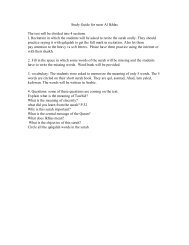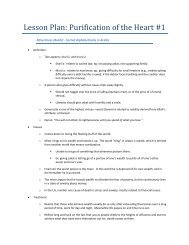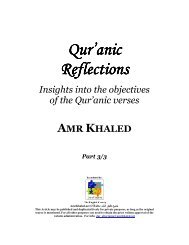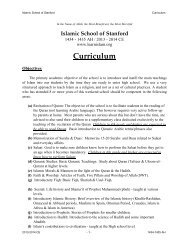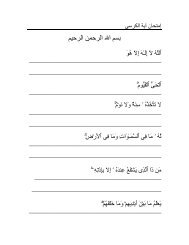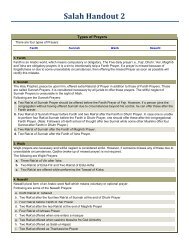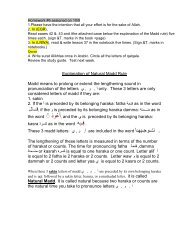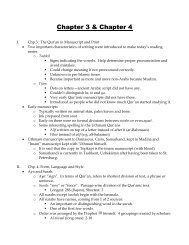Quranic Reflections - Islamic School of Stanford
Quranic Reflections - Islamic School of Stanford
Quranic Reflections - Islamic School of Stanford
Create successful ePaper yourself
Turn your PDF publications into a flip-book with our unique Google optimized e-Paper software.
Hajj and the scenes <strong>of</strong> the Day <strong>of</strong> Judgment<br />
The Ayahs start afterwards to depict the horrors <strong>of</strong> that day, so you can feel as if you<br />
see them in front <strong>of</strong> your eyes: “The Day you shall see it, every nursing mother will<br />
forget her nursling, and every pregnant one will drop her load, and you shall see<br />
mankind as in a drunken state, yet they will not be drunken, but severe will be<br />
the Torment <strong>of</strong> Allah” (TMQ, 22: 2).<br />
The Ayahs then shift to resurrection and the scene <strong>of</strong> people getting out <strong>of</strong> their<br />
graves, with dust covering their faces and bodies. Hence, the Ayah reminds us that all<br />
people were originally created from dust. “O mankind! If you are in doubt about<br />
the Resurrection, then verily We have created you (i.e. Adam) from dust…”<br />
(TMQ, 22: 5).<br />
After two days <strong>of</strong> wearing the Hajj clothes, you become covered with dust from tip to<br />
toe. What is more important is when you perform the Hajj exactly as the Prophet<br />
(SAWS) did. If you decide to spend your night at Mozdalifa, you see most <strong>of</strong> the<br />
people extremely tired, as if they are dead. At dawn people rush out <strong>of</strong> their place <strong>of</strong><br />
residence as if they are rising from graves; all <strong>of</strong> them are wearing white clothes and<br />
move towards the place where the ritual <strong>of</strong> the throwing <strong>of</strong> stones can be performed.<br />
Therefore, the Ayah comes as a reminder <strong>of</strong> resurrection, as Allah (SWT) says what<br />
can be translated as, “And surely, the Hour is coming, there is no doubt about it;<br />
and certainly, Allah will resurrect those who are in the graves” (TMQ, 22: 7).<br />
Thus, we see the first result <strong>of</strong> Hajj in educating Ummah (<strong>Islamic</strong> nation) preparing<br />
muslims them for the Day <strong>of</strong> Judgment, through the experience they live while<br />
performing Hajj rituals.<br />
Hajj rituals: the utmost obedience to Allah (SWT):<br />
The Ayahs 26-37 mention the various Hajj rituals, the until reaching the central Ayah<br />
comes which can be translated as, “and whosoever honors the Symbols <strong>of</strong> Allah,<br />
then it is truly from the piety <strong>of</strong> the hearts” (TMQ, 22: 32).<br />
What is the Divine wisdom behind these great rituals<br />
During Hajj, you should carry out strict and specific directives imposed by Allah<br />
(SWT) otherwise your hajj is spoilt. A Muslim circumambulates seven times around a<br />
stone; goes to and fro seven times between two stones; and throws stones on a place<br />
full <strong>of</strong> stones. He/She performs many rituals may be without knowing the real<br />
wisdom lying behind, yet he/she only performs them in obedience to Allah’s (SWT)<br />
orders. This is the utmost form <strong>of</strong> obedience to Allah (SWT). The Muslim is also<br />
prepared through such rituals to another religious duty in Islam: Jihad (fight for the<br />
cause <strong>of</strong> Allah).<br />
Hajj and Jihad:<br />
The Ayahs about Jihad come immediately after those talking about Hajj. Allah (SWT)<br />
says what can be translated as, “Truly, Allah defends those who believe” (TMQ,



